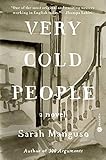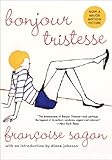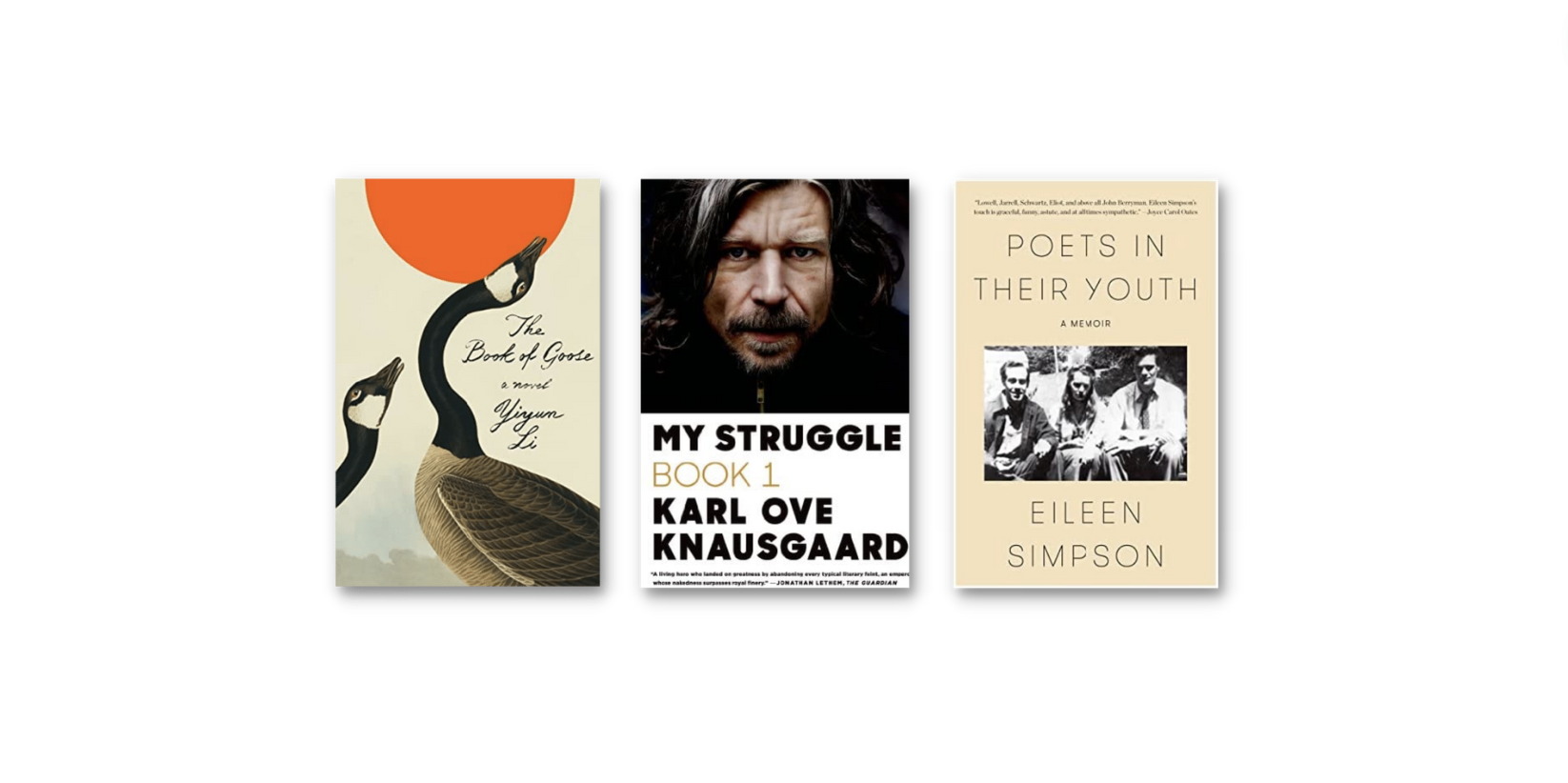 My midlife condition is “not enough time to read”—but years begin with such a sense of possibility. I remember this January felt particularly free and expansive, because my husband was away for the month at a writing residency. I wanted to use all that cold and alone time to do some writing of my own, and that directed my reading. I posted up in John’s vacated office, moved a space heater under his desk and got a huge stack of architecture books from the library. When I wasn’t flipping through those I read Stephen Mitchell‘s translation of The Notebooks of Malte Laurids Brigge, Rilke’s only novel, and though I love Rilke and I love poets’ novels, I still almost couldn’t believe how much I loved it, a gorgeous pseudo-nonfictional fiction that is also on some level pseudo-fictional nonfiction, Proustian and pre-Sebaldian. An almost random collage of the kinds of passages that make novels worth reading, but without the connective tissue of plot or even some form of linearity: The first entry of the “Notebooks” has a date, but that’s the only date; are we meant to believe all these pages spilled out in one day? It would suit the sensibility of the novel, one in which time spills out of time, in which “it was really afternoon and remained afternoon and never stopped being afternoon” … “Everything is here. Everything forever.” Memory locks time into an object, “one of those moments that are eternity.” I love the urge in this book to reach out to the childhood self, that poor creature all crouched in its fear and trembling, and offer the sympathy it never got enough of, and recount the experiences it couldn’t understand while they were happening, though the child was not wrong—life is terrifying and mysterious still.
My midlife condition is “not enough time to read”—but years begin with such a sense of possibility. I remember this January felt particularly free and expansive, because my husband was away for the month at a writing residency. I wanted to use all that cold and alone time to do some writing of my own, and that directed my reading. I posted up in John’s vacated office, moved a space heater under his desk and got a huge stack of architecture books from the library. When I wasn’t flipping through those I read Stephen Mitchell‘s translation of The Notebooks of Malte Laurids Brigge, Rilke’s only novel, and though I love Rilke and I love poets’ novels, I still almost couldn’t believe how much I loved it, a gorgeous pseudo-nonfictional fiction that is also on some level pseudo-fictional nonfiction, Proustian and pre-Sebaldian. An almost random collage of the kinds of passages that make novels worth reading, but without the connective tissue of plot or even some form of linearity: The first entry of the “Notebooks” has a date, but that’s the only date; are we meant to believe all these pages spilled out in one day? It would suit the sensibility of the novel, one in which time spills out of time, in which “it was really afternoon and remained afternoon and never stopped being afternoon” … “Everything is here. Everything forever.” Memory locks time into an object, “one of those moments that are eternity.” I love the urge in this book to reach out to the childhood self, that poor creature all crouched in its fear and trembling, and offer the sympathy it never got enough of, and recount the experiences it couldn’t understand while they were happening, though the child was not wrong—life is terrifying and mysterious still.



 I read a few other poets’ novels in 2022, some new (Sarah Manguso’s Very Cold People, Jordan Castro’s The Novelist) and some old—I especially loved James Welch’s Winter in the Blood, which reminded me somehow of Denis Johnson, who was also a poet (and a very good poet, always better than I remember). Other standouts from my fiction reading: Time’s Arrow by Martin Amis, with its totally wild premise that seems impossible to sustain for the length of a novel—the narrator is something like the soul of a Nazi war criminal; with no memory of his past he is forced to live through his life again, from death to birth, backwards—but I thought it was great, very funny and quite profound, with many beautiful sentences, as we used to say. A meditation on the strange correspondences between before and after, the senselessness of consequence and causality. Once you’re alive, in backwards time, you can’t get out until you’re born; there is no suicide. “I don’t get it. Are we all slaves? Are we somehow less than slaves?”
I read a few other poets’ novels in 2022, some new (Sarah Manguso’s Very Cold People, Jordan Castro’s The Novelist) and some old—I especially loved James Welch’s Winter in the Blood, which reminded me somehow of Denis Johnson, who was also a poet (and a very good poet, always better than I remember). Other standouts from my fiction reading: Time’s Arrow by Martin Amis, with its totally wild premise that seems impossible to sustain for the length of a novel—the narrator is something like the soul of a Nazi war criminal; with no memory of his past he is forced to live through his life again, from death to birth, backwards—but I thought it was great, very funny and quite profound, with many beautiful sentences, as we used to say. A meditation on the strange correspondences between before and after, the senselessness of consequence and causality. Once you’re alive, in backwards time, you can’t get out until you’re born; there is no suicide. “I don’t get it. Are we all slaves? Are we somehow less than slaves?”

 I also loved The Book of Goose. Like everything I’ve read by Yiyun Li, it’s strange, aphoristic, riddle-like, beautiful, and chilling. A woman, Agnes, looks back on a childhood friendship after hearing that her friend, Fabienne, has died in childbirth. Their relationship in a small French town, post-war, was intense, full of lies and unspoken dares and schemes, games that became dangerous. Out of boredom of a sort, they enlist an old widow in their village to help them get a book published, then betray him. This ultimately separates the girls. The questions of devotion and betrayal are complex, and the friendship, or their love, over time proves impossible. During the summer while I was reading this, I was also following the saga of a stray cat, Tiger, who lives in my mother-in-law’s backyard and environs, coming to the back door once or twice a day for a plate of food and often lounging in the sun by her pool. The house cats, originally strays themselves, stare at Tiger through the glass door; it’s all very Dickensian. Tiger often shows up with an injury, a bloody scratched nose or an eye—there are all kinds of wild animals around her house, raccoons and possums, etc.—and one week he looked especially piteous, limping across the deck, with perhaps a broken leg. The house cats are afraid of Tiger, so my mother-in-law thinks he’s mean. But wouldn’t you be mean? Fabienne is like that, an orphan, poor and unattractive and menacing, yet Agnes is devoted, and happy to let Fabienne criticize and control her. It’s Fabienne who writes the book, but they claim it was Agnes, because Agnes is pretty and docile and more likely to get famous (like Francoise Sagan, whose Bonjour Tristesse, by coincidence, I also read this year). Agnes never thinks of herself as a writer, but this book, the story we are reading, is written by Agnes. Was she as passive and stupid as they seemed to believe, or was that another game? Or did their mysterious union give them both power, these grieving, powerless girls, trying to escape? “True blind rage is like true blind courage.” What was real for them was the world they made themselves, and nothing would ever be that real again. (As Mary Gaitskill wrote, in a piece about the ineffable “viscera” of fiction: “what’s hidden is most real and we may never truly see it.”)
I also loved The Book of Goose. Like everything I’ve read by Yiyun Li, it’s strange, aphoristic, riddle-like, beautiful, and chilling. A woman, Agnes, looks back on a childhood friendship after hearing that her friend, Fabienne, has died in childbirth. Their relationship in a small French town, post-war, was intense, full of lies and unspoken dares and schemes, games that became dangerous. Out of boredom of a sort, they enlist an old widow in their village to help them get a book published, then betray him. This ultimately separates the girls. The questions of devotion and betrayal are complex, and the friendship, or their love, over time proves impossible. During the summer while I was reading this, I was also following the saga of a stray cat, Tiger, who lives in my mother-in-law’s backyard and environs, coming to the back door once or twice a day for a plate of food and often lounging in the sun by her pool. The house cats, originally strays themselves, stare at Tiger through the glass door; it’s all very Dickensian. Tiger often shows up with an injury, a bloody scratched nose or an eye—there are all kinds of wild animals around her house, raccoons and possums, etc.—and one week he looked especially piteous, limping across the deck, with perhaps a broken leg. The house cats are afraid of Tiger, so my mother-in-law thinks he’s mean. But wouldn’t you be mean? Fabienne is like that, an orphan, poor and unattractive and menacing, yet Agnes is devoted, and happy to let Fabienne criticize and control her. It’s Fabienne who writes the book, but they claim it was Agnes, because Agnes is pretty and docile and more likely to get famous (like Francoise Sagan, whose Bonjour Tristesse, by coincidence, I also read this year). Agnes never thinks of herself as a writer, but this book, the story we are reading, is written by Agnes. Was she as passive and stupid as they seemed to believe, or was that another game? Or did their mysterious union give them both power, these grieving, powerless girls, trying to escape? “True blind rage is like true blind courage.” What was real for them was the world they made themselves, and nothing would ever be that real again. (As Mary Gaitskill wrote, in a piece about the ineffable “viscera” of fiction: “what’s hidden is most real and we may never truly see it.”)

 As I write this, I’ve just finished Book 1 of My Struggle. I’m not sure why I decided it was time to read Knausgaard, but after reading Crossroads last December, I think I may start a new ritual of reading long novels around the holidays. It got me thinking about a certain mode in literature, a mode of desperation, where the “sentences” per se don’t really matter—it doesn’t matter if the sloppiness is Knausgaard’s or the translator’s, because the formal concerns are not sentence-level. The point is volume and speed, like a waterfall, or vomit, and any meaninglessness at the micro-level still serves the macro-level meaning: the whole point of a life story is that it must be told, now, before it’s too late, and the life story contains all of the life. This seems to me one of those books in which the parts makes sense only in the context of the whole; an excerpt wouldn’t really tell you much about the overall effect. The truly essayistic passages are minimal compared to the detailed narrative parts, but important. I find his viewpoints on art very moving, and his idea that passion, ambition, and stamina have more to do with greatness than talent does, that greatness is something you can choose, and that he cares about this, about art as a purpose, more than happiness. “Joy is not my goal, never has been, what good is joy to me?”
As I write this, I’ve just finished Book 1 of My Struggle. I’m not sure why I decided it was time to read Knausgaard, but after reading Crossroads last December, I think I may start a new ritual of reading long novels around the holidays. It got me thinking about a certain mode in literature, a mode of desperation, where the “sentences” per se don’t really matter—it doesn’t matter if the sloppiness is Knausgaard’s or the translator’s, because the formal concerns are not sentence-level. The point is volume and speed, like a waterfall, or vomit, and any meaninglessness at the micro-level still serves the macro-level meaning: the whole point of a life story is that it must be told, now, before it’s too late, and the life story contains all of the life. This seems to me one of those books in which the parts makes sense only in the context of the whole; an excerpt wouldn’t really tell you much about the overall effect. The truly essayistic passages are minimal compared to the detailed narrative parts, but important. I find his viewpoints on art very moving, and his idea that passion, ambition, and stamina have more to do with greatness than talent does, that greatness is something you can choose, and that he cares about this, about art as a purpose, more than happiness. “Joy is not my goal, never has been, what good is joy to me?”

 I typically finish more novels than I do nonfiction books, nonfiction being easier to skim and sort of plunder, like picking through mixed nuts. I didn’t finish any of those architecture books, though I felt a lot of joy (apologies to Karl Ove) flipping through them—especially Christopher Alexander’s A Pattern Language, which I initially discovered in grad school, found fascinating then and still find fascinating—but on this read I found it had so much to say about writing, how much building a house is like writing a book. “It is possible to put patterns together in such a way that many patterns overlap in the same physical space: the building is very dense; it has many meanings captured in a small space; and through this density, it becomes profound” … “Every building, every room, every garden is better, when all the patterns which it needs are compressed as far as it is possible for them to be. The building will be cheaper; and the meanings in it will be denser” … “above all, work on the site, stay on the site, let the site tell you its secrets.” I also founds lots of good covert writing advice in Complexity and Contradiction in Architecture by Robert Venturi (“Mies makes wonderful buildings only because he ignores many aspects of a building. If he solved more problems, his buildings would be far less potent.”).
I typically finish more novels than I do nonfiction books, nonfiction being easier to skim and sort of plunder, like picking through mixed nuts. I didn’t finish any of those architecture books, though I felt a lot of joy (apologies to Karl Ove) flipping through them—especially Christopher Alexander’s A Pattern Language, which I initially discovered in grad school, found fascinating then and still find fascinating—but on this read I found it had so much to say about writing, how much building a house is like writing a book. “It is possible to put patterns together in such a way that many patterns overlap in the same physical space: the building is very dense; it has many meanings captured in a small space; and through this density, it becomes profound” … “Every building, every room, every garden is better, when all the patterns which it needs are compressed as far as it is possible for them to be. The building will be cheaper; and the meanings in it will be denser” … “above all, work on the site, stay on the site, let the site tell you its secrets.” I also founds lots of good covert writing advice in Complexity and Contradiction in Architecture by Robert Venturi (“Mies makes wonderful buildings only because he ignores many aspects of a building. If he solved more problems, his buildings would be far less potent.”).
 A book I read cover to cover was Poets in Their Youth by Eileen Simpson, a memoir that reads like a group biography—Simpson was John Berryman’s first wife, and this is a meandering portrait of Berryman and the other writers they spent time with in the ‘40s and ‘50s—Delmore Schwartz, Robert Lowell (nicknamed “Cal,” I only finally learned from this book, after Caligula!), Jean Stafford, Richard Blackmur, Randall Jarrell, Elizabeth Hardwick, Edmund Wilson, etc.—so many of whom had intense and tragic lives, the kind of life Simpson finally decided she wanted out of. Young Berryman was so much like someone I would have known in my MFA days. It made me so happy and sad, as life does.
A book I read cover to cover was Poets in Their Youth by Eileen Simpson, a memoir that reads like a group biography—Simpson was John Berryman’s first wife, and this is a meandering portrait of Berryman and the other writers they spent time with in the ‘40s and ‘50s—Delmore Schwartz, Robert Lowell (nicknamed “Cal,” I only finally learned from this book, after Caligula!), Jean Stafford, Richard Blackmur, Randall Jarrell, Elizabeth Hardwick, Edmund Wilson, etc.—so many of whom had intense and tragic lives, the kind of life Simpson finally decided she wanted out of. Young Berryman was so much like someone I would have known in my MFA days. It made me so happy and sad, as life does.
More from A Year in Reading 2022
A Year in Reading Archives: 2021, 2020, 2019, 2018, 2017, 2016, 2015, 2014, 2013, 2012, 2011, 2010, 2009, 2008, 2007, 2006, 2005









